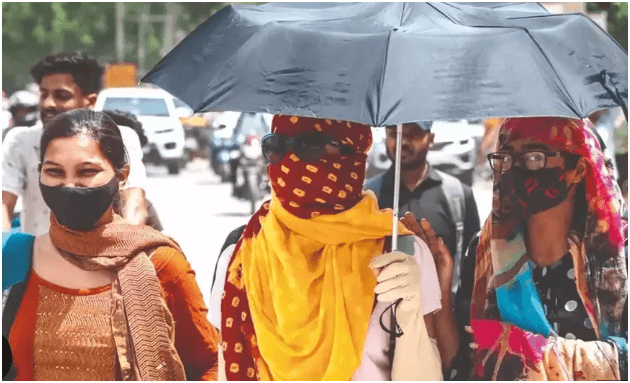Delhi Weather: IMD Issues ‘Orange Alert’ for Severe Heatwave
The Regional Meteorological Centre in New Delhi has issued a detailed forecast for the city’s weather, predicting partly cloudy skies on Thursday, May 30. The India Meteorological Department (IMD) has shifted from a ‘red alert’ to an ‘orange alert’ for the day, anticipating heatwave conditions in specific areas. Additionally, there is a possibility of a thunderstorm with very light rain or drizzle.
According to the IMD’s regional office, Delhi is expected to experience a maximum temperature of around 45°C on Thursday. The weather prediction includes:
- Partly cloudy skies.
- Heatwave conditions in some areas.
- Potential thunderstorms or dust storms accompanied by very light rain or drizzle, along with gusty winds ranging from 25-35 km/h.
The regional meteorological centre predicts that the city’s weather will remain cloudy until June 1, with no significant rainfall anticipated until June 4. Kuldeep Srivastava, head of the Regional Weather Forecasting Centre, IMD, stated that a reduction in temperature by 2-3 degrees is expected on Thursday due to western disturbances. He added, “On May 31st and June 1st, there is a possibility of thunderstorms and lightning in Delhi-NCR and the entire Northwest region. By June 1st, there will be a 3-4 degrees reduction in temperature.”
Maximum Temperatures Across Delhi
As of 8:30 am on Thursday, the maximum temperatures recorded at various locations in Delhi were:
- Safdarjung: 46.8°C
- Palam: 47.0°C
- Lodhi Road: 46.2°C
- Ridge: 47.3°C
- Ayanagar: 46.8°C
The IMD announced on Wednesday that the ongoing heatwave to severe heatwave conditions in Northwest and Central India are expected to gradually diminish from May 30. On Wednesday, Delhi experienced extreme heat, with temperatures soaring to an unprecedented 52.3°C at 3:15 pm in Mungeshpur, located in the city’s northwestern outskirts. This marked the highest temperature ever recorded in India.
However, Union Minister for Earth Sciences, Kiren Rijiju, expressed skepticism about the reported temperature. In a post on X, he stated, “It is not official yet. A temperature of 52.3°C in Delhi is very unlikely. Our senior officials in IMD have been asked to verify the news report. The official position will be stated soon.”
The severe heatwave has had significant effects on daily life in Delhi. Residents are advised to take precautions to avoid heat-related illnesses. The extreme temperatures can lead to heat exhaustion and heatstroke, especially among vulnerable populations such as the elderly, children, and those with pre-existing health conditions.
The IMD and health authorities have issued advisories for the public to stay hydrated, avoid direct sunlight during peak hours, and wear light, breathable clothing. It is also recommended to stay indoors as much as possible and to avoid strenuous physical activities during the hottest parts of the day.
Local authorities have set up cooling centers and hydration stations across the city to provide relief to residents. These centers offer shaded areas, water, and basic medical assistance to those affected by the heat. Additionally, public awareness campaigns are being conducted to educate citizens about the dangers of heatwaves and the necessary precautions.
With the predicted thunderstorms and temperature reductions due to western disturbances, there is hope for some relief from the intense heat. The weather pattern is expected to shift, bringing more manageable conditions. However, the long-term trend of rising temperatures highlights the ongoing challenges posed by climate change.
The increasing frequency and intensity of heatwaves in India are consistent with global patterns attributed to climate change. Experts emphasize the need for adaptive measures to mitigate the impact of extreme weather events. This includes enhancing infrastructure to cope with high temperatures, improving public health responses, and implementing sustainable practices to reduce overall climate impact.
The Indian government has been actively monitoring the situation and coordinating efforts to manage the heatwave’s impact. Emergency services are on high alert to respond to heat-related incidents, and efforts are being made to ensure that essential services, such as electricity and water supply, remain uninterrupted.
Meteorologists continue to study weather patterns to provide accurate forecasts and timely warnings. The IMD’s ability to predict and communicate severe weather conditions is crucial in minimizing the adverse effects of heatwaves. Enhanced prediction models and better dissemination of information can help communities prepare and respond more effectively.
The IMD’s orange alert for Delhi underscores the severity of the current heatwave. As temperatures remain high and the potential for thunderstorms looms, residents must stay vigilant and take necessary precautions. The gradual decrease in temperature predicted for the coming days offers some hope for relief, but the challenges of extreme heat will persist. Continued efforts to address climate change and improve resilience against heatwaves are essential for safeguarding public health and well-being in the future.
